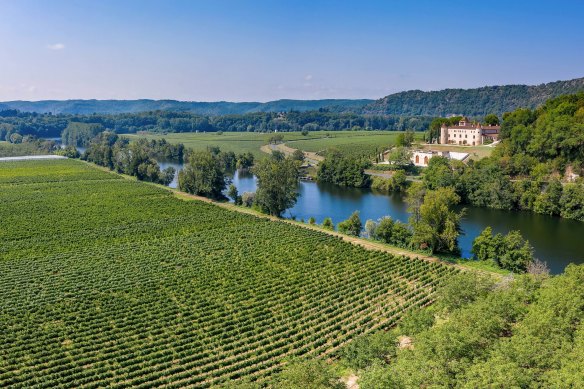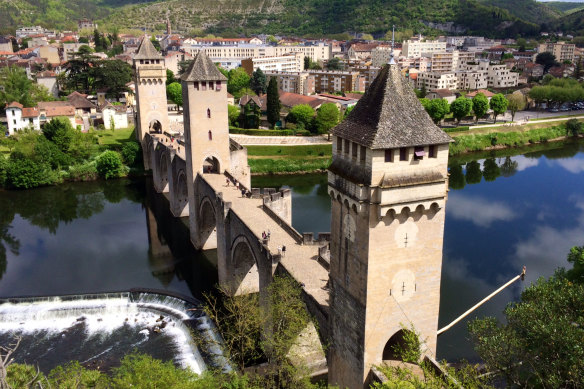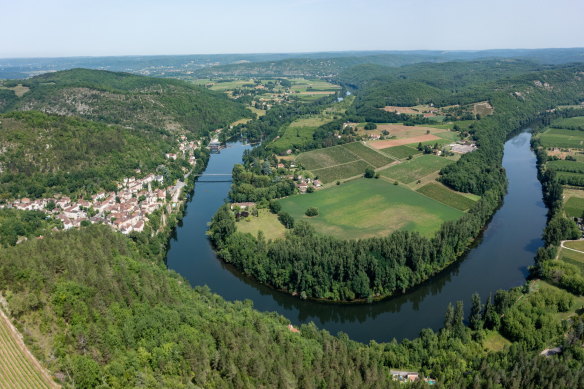
Deer scurry between the tall oak trees in our garden and we have a truffle farmer for a neighbour. I can count the number of cars that pass by our house in a day on one hand – and the number of tractors on the other. On clear nights, the ink-black sky lights up like a child’s bedroom ceiling crammed with glow-in-the-dark stickers. The stars shimmer with glee at the glorious lack of light pollution.
It turns out, however, that we’re in good company, for the Lot is also a part of the world so favoured by the Danish monarchy that they even own a castle here, Chateau de Cayx. And in more recent years, it has been the children of (now) King Frederik and Queen Mary who locals spot running down cobbled streets on balmy summer days.

Chateau de Cayx and its vineyards.
It seems many people in the Lot have their own royal story to share. A few years ago, a fellow travel writer stopped in at a butcher’s just off the main square in Cahors, the capital of the department. As she and her brother waited to choose their cuts of meat, the lady in front of them paid for her purchases. “To my astonishment, the butcher said ’merci beaucoup, votre Majeste (thank you, Your Majesty!)″. It was Queen Margrethe!” she recalled on a shared WhatsApp group.
Queen Margrethe and her French-born husband, Prince Henrik, or Henri de Laborde de Montpezat by birth, purchased the tumbling 15th-century chateau overlooking the river in 1974, when their two princes were still aged in single digits. The family set about bringing it back to its former glory, keeping with the south-west style of exposed stone walls and terracotta roof tiles. They soon slipped into an easy rhythm of summers at the sprawling property.
It’s a tradition Margrethe has continued, even after her husband died in 2018. According to local chat, she arrives with little fanfare, flying into Toulouse’s Blagnac airport where her late husband’s former secretary waits to collect her by car for the two-hour drive north.
The chateau overlooks the family’s impressive wine estate that stretches as far as the riverbank. The Danes have earned quite a reputation for their fine malbecs, the main grape in these parts — although here it goes by the name Cahors, in the French way of naming wines by place rather than variety.

Cahors charms with its 14th century stone arched bridge, Pont Valentre.
One of the country’s great red wines — even if it’s often referred to as the “black wine” because of its depth of colour — the appellation fans far wider than the town of Cahors itself, which sits all snug in the horseshoe-shaped bend of the river and charms with its 14th century stone arched bridge, Pont Valentre.
In summer, there’s a chance you’ll cross paths with a royal at Cahors’ lively market that takes over Place Chapou on Wednesday and Saturday mornings. Queen Mary, in her usual sartorial style, has been papped blending in with a relaxed crowd who fill wicker baskets to the brim with local specialities, including something inevitably made from duck.
Loading
From Cahors, it’s an easy 20-minute drive back to Chateau de Cayx along a road that barely lets the meandering Lot from its sights. The nearest village, Luzech, has pretty river views, although King Frederik can trace his family on his father’s side to Albas, one bend further west along the river (or a pleasant two-hour walk along a peaceful towpath).
Also known as Albas la Jolie (Albas the Pretty), the village lives up to its name, a photogenic explosion of iguana-green foliage jostling against worn stone houses along the riverbank. Surveying the scene is an old bishop’s palace, newly planted with a tranquil Tuscan garden, an Italian region this part of the country has been likened to.

The Lot River making a turn past the village of Albas.
My pick of the villages clinging to the river bank, however, is Saint-Cirq-Lapopie, a medieval village so idyllic it could be a Disney set. Peeping out over the river from its lofty perch, its narrow alleyways brim with artisan shops, cosy restaurants and bright flower boxes. Labelled one of Les Plus Beaux Villages en France, it’s a name that doesn’t attract the same sort of revered international recognition as Gordes and Saint Paul de Vence in Provence, but you get the feeling the French are happy to keep it under wraps: they have, after all, voted it as one of their favourite villages in the country.
I haven’t spotted any Scandinavian monarchy there, or anywhere in the Lot — yet — but I have met more Australians than I could have ever imagined. There’s a group of friends from Melbourne who pitched in to buy a couple of apartments in Montcuq a couple of decades ago and continue to visit regularly on a time-share basis. For Bastille Day celebrations last summer, we were among at least a dozen Aussies watching fireworks burst from the top of the donjon into the rural night sky to the opening chords of Thunderstruck. It all felt so familiar, in a corner of the world least expected.
Maybe this year we’ll have to extend an invitation to our Aussie neighbour, Queen Mary.
Loading
The details
Visit
You can buy wine and other royal souvenirs at the small shop onsite at Chateau de Cayx, open Monday to Saturday year round. See chateau-de-cayx.com
Fly
Qatar Airways flies daily between Sydney, Melbourne and Brisbane and Doha and three times a week from Doha to Toulouse. See qatarairways.com
Stay
Surrounded by Malbec vineyards on the banks of the river Lot, Chateau de Mercues is a fit-for-a-royal-family 13th century castle with a Michelin star restaurant, Le Dueze. It’s also a Relais & Chateaux property; rooms from €295 ($478). See chateaudemercues.com
More
tourisme-lot.com



























